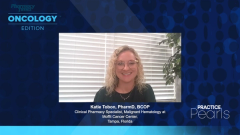
Managing AEs With BTK Inhibitors in CLL
Lisa Nodzon, PhD, ARNP, AOCNP; Katie Tobon, PharmD, BCOP; and Javier Pinilla-Ibarz, MD, PhD, share insight on strategies for the monitoring and management of BTK inhibitor–associated toxicities in CLL and review the importance of a multidisciplinary approach to treatment.
Episodes in this series

Javier Pinilla-Ibarz, MD, PhD: In the last part of this wonderful conversation, we’re going to discuss the management of BTK [Bruton tyrosine kinase] inhibitor–associated toxicity. This is something we discuss among us all the time because we need to be prepared and ready to work so we can keep patients on the drug. That’s the goal. Let’s review the adverse events as we share with BTK inhibitors, and let’s go to the first questions. What monitoring and management strategies do you recommend? These are going to bring you a few issues. What are the key parameters to monitor when patients are on these BTK inhibitors? When should patients be followed? When should we do these follow-ups, and how we are sure that these patients achieve the optimal care? How do we deal with the adverse effects? Let’s start with Lisa. Katie you can jump in anytime.
Lisa Nodzon, PhD, ARNP, AOCNP:Whenever it comes time to start a patient on therapy, it takes several of us to get 1 patient going. Typically, the conversation is starting with the adverse-effect profile right after the decision is made about which therapy the patient will go on. With BTK inhibitors, in general, the first thing we’re cognizant of is the patient sitting before us, that they’re likely coming in with some comorbid conditions. For the patients coming in with hypertension or a history of atrial fibrillation or arrhythmias, or perhaps are on some other medications—particularly cardiac medications, which may have significant interactions—we have to consult with pharmacy.
Katie comes into play when we’re looking at the medication list that the patient may be on, and we’re trying to see if the patient can be switched out. The first thing is concomitant medications. We’re very fortunate at our institution [Moffitt Cancer Center] to have a cardio-oncologist who’s very familiar with these agents. For patients coming in with underlying comorbid conditions—arrhythmias, on antiplatelet drugs or direct oral anticoagulants, hypertension history—we want them to be engaged with our cardio-oncologist to make sure we can fine-tune things. With BTK inhibitors, the risk for cardiac arrhythmia and bleeding are omnipresent. Hypertension isn’t an immediate adverse event or risk, but it can occur in time with the patient. Most providers and even some patients don’t think about it.
We tend to think that when we start drugs, the adverse effects that the patient is going to experience are going to be in the first few weeks, but hypertension is 1 that can come in time. We want to make sure we’re fine-tuned from the start and that our patients are on therapy. But most important, once the patient starts on drug, we want to see them pretty closely in follow-up. We recognize that the patient might be absorbing 20% of the conversation when told, “This is the therapy you’re going to be receiving. This is the adverse effect.” All that patient education is not absorbed at that appointment. We like to see those patients weekly, at least for the first month, and then graduate them out a little thereafter. At least for those first 3 months, we’re following those patients pretty closely.
Another big teaching point that we have to discuss with our patients is the mechanistic effect of the drug. We can see an increased lymphocytosis with these BTK inhibitors because of the blocking of a signal, where you’ll see an increase in peripheral lymphocytosis in addition to the regression in the lymphadenopathy. A lot of education has to go with our patients to explain that this isn’t a disease progression. Rather, this is a mechanism of the drug. But we might see this increased lymphocytosis for a while, but concomitantly we have to be monitoring out as well for uric acid levels. We don’t see true tumor lysis, but hyperuricemia can occur as well with a cell turnover.
We also have to pay attention to patients who are starting with cytopenia. BTK inhibitors don’t rapidly clean out the bone marrow, for lack of a better term. Sometimes those cytopenia do get worse before they get better, particularly the anemia from the cytopenia. We’re cognizant of looking out for neutropenia and treating that with an aggressive growth factor, but seeing that patient in pretty close follow-up at least for those initial 3 months is important. Because of those visits, you’re recirculating that patient education, which maybe they’re not absorbing in the beginning. But you’re also reiterating the adverse effects of the drug that the patient may be experiencing.
Arthralgia is probably the most difficult toxicities to manage. Why is that? Well, we know our patients can come into this disease with underlying arthritis or rheumatologic conditions, and now you’re going to impart a drug on the patient that can give them arthralgias. Sometimes we’ve seen pretty debilitating arthralgias in our patient population. The treatment of choice typically is an NSAID [nonsteroidal anti-inflammatory drug]. We all want to doit, but patients are at an increased risk for bleeding with BTK inhibitors as a class effect. Giving them a concomitant NSAID could also increase the risk for bleeding, particularly GI [gastrointestinal] bleeding. Sometimes, we have to manage that with dosing modifications. Occasionally we’ll give the patient a Medrol pack as well. But arthralgia is the 1 that can be most difficult to manage.
Sometimes we see skin rashes as well on our patients. We have to make sure we’re discerning that it’s not shingles and not TKI [tyrosine kinase inhibitor] in our patient population. We like to see those patients in clinic pretty close in the beginning. Diarrhea is 1 that we can also see in our patient population. Because this is an older population, diarrhea could be debilitating to our patients, resulting in quick electrolyte imbalances; it’s fatiguing on them too. It’s something else that we have to closely watch out for in our patient population. It takes a lot of people to get a patient started on a BTK inhibitor, from the pharmacist to the nurse, who are calling the patient within the first week to make sure the patient is doing well on the drug and taking the drug appropriately…. As Katie mentioned earlier, taking it consistently is important because sometimes, our patients may be taking it a little more or less than. Maybe at the 24-hour period or during the 12 hours or unsure. “Can I take this with food or water?” Maybe they didn’t remember, or maybe we missed a medication that perhaps should have been on their medication list but was not. Now is a good time to go through the medication list again with the patient.
Javier Pinilla-Ibarz, MD, PhD: That was excellent.
Katie Tobon, PharmD, BCOP: You brought up a lot of great points. The only thing that I would add is that ibrutinib and acalabrutinib, or BTK inhibitors, are most of the time prescribed from a specialty pharmacy. These patients have other comorbid conditions that they see their PCP [primary care physician] for, and they’re getting their normal medications filled at a CVS or Walgreens. These specialty medications may not be on that medication list. This is where we’ve caught a lot of potential drug interactions. It’s important that patients understand that we need to be in the know of all medications they’re on all the time. There’s also the risk of bleeding. They need to hold them at the BTK inhibitor anywhere from 3 to 7 days pre and post a procedure, including a dental pulling. The dentist may not think to ask about a bleeding recipe on a BTK inhibitor. Lisa brought up a lot of great points. It’s important that we monitor these patients up front and that patients understand that just because they aren’t having an adverse effect during the first week of treatment, that doesn’t mean it may not show up 6 months down the line.
Javier Pinilla-Ibarz, MD, PhD: Excellent points. You guys hit on everything. I want to emphasize the flexibility of the therapies we have, and the possibility that we can deal with modifications to improve, or at least to try to mitigate some of the adverse effects that we’re discussing. In the end, we want patients to stay on the drugs as long as they can. There’s no doubt that intolerance is something we deal with in our daily practice. The more drugs that are available, the more intolerance we’re going to see. Hopefully, we’re going to continue to take care of our patients.
I also want to emphasize that it’s a multidisciplinary team effort, as you guys pointed out multiple times. We have great pharmacists, advanced practitioners, and nurses taking on patients to see how they’re doing. At the same time, we collaborate closely with our fellow cardio-oncologists and other parts of the team because it’s important to bring it all together. More recently, IV [intravenous] also play a role in new problems with COVID-19, where we’re trying to be very careful of how our patient deals with this problem.
This was an excellent conversation. Thank you and to our viewing audience. We hope you found these Pharmacy Times® Physicians Practice Pearls® to be rich and informative. Thank you very much for your attention.
Transcript Edited for Clarity
Newsletter
Stay informed on drug updates, treatment guidelines, and pharmacy practice trends—subscribe to Pharmacy Times for weekly clinical insights.











































































































































































































